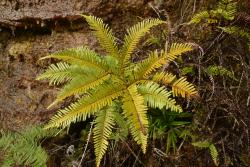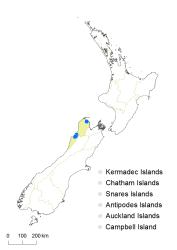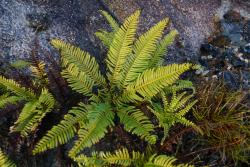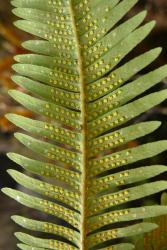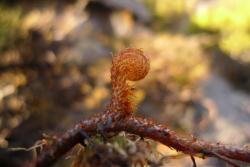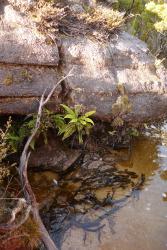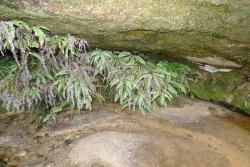Rhizomes long-creeping, 2–5 mm diameter; rhizome scales lanceate or ovate, 1.7–4.2 mm long, 0.5–0.8 mm wide, brown, ciliate. Fronds 120–930 mm long. Stipes 40–600 mm long, scaly proximally or glabrous. Laminae 65–390 mm long, 75–390 mm wide, green on both surfaces, herbaceous, scaly. Rachis buds not extending or sometimes extending once (rarely twice), scaly; sometimes pseudostipulate, with a single, usually lobed costal segment near base of each flanking branch. Rachis bud scales lanceate, rarely ovate, 1.7–3.5 mm long, 0.3–0.7 mm wide, brown, ciliate. Pinnae 70–390 mm long, 30–180 mm wide; with 2 (occasionally 0, 1 or 3) successive pseudodichotomous forks (excluding growth from pinna buds); pinna buds not extending or rarely extending once. Proximal-most (primary) costae 11–32 mm long, with 0–4 pairs of costal segments (excluding pseudostipules). β costae 26–65 mm long, with 5–13 pairs of costal segments. Ultimate leaflets narrowly ovate or narrowly elliptic, 60–280 (rarely 310) mm long, 15–54 (rarely 90) mm wide, angustate or caudate, usually mostly straight; with 21–58 pairs of ultimate segments; pairs in centre of lamina diverging 40–60° (occasionally 30°). Abaxial surface of α costae scaly; scales acicular, 1000–2100 µm long, 80–180 µm wide, brown, ciliate, glabrescent. Ultimate segments narrowly oblong (rarely linear), 8–30 (rarely 52) mm long, 1.5–3 (rarely 4) mm wide, arising at 60–70° from α costae, usually crenulate or rarely entire, acute; abaxial surface with pale stellate scales that resemble branched hairs, glabrescent. Sori 3–16 either side of midvein, usually with 3–5 sporangia each. Spores 38–43 µm long, 19–23 µm wide (5 samples, 2 populations).
The crenulate and abaxially green ultimate segments, acicular or hair-like scales on the abaxial surface of the α costae, and the ultimate segments arising at ≤70° from the α costae distinguish Sticherus urceolatus from S. cunninghamii and S. tener. Sticherus urceolatus is very similar to S. flabellatus, but the former usually has shorter α costae relative to the proximal-most costae, and less pronounced serrations on the ultimate segments. The difference in ploidy is reflected in the larger spore size of S. urceolatus (38–43 µm long, 19–23 µm wide cf. 32–35 µm long, 17–19 µm wide for S. flabellatus). In New Zealand, S. urceolatus (northern and western South Island) and S. flabellatus (northern North Island) are allopatric.
South Island: Western Nelson.
Altitudinal range: 0–900 m
Sticherus urceolatus occurs in Golden Bay near the coast, and near Westport, on and between the Stockton and Denniston Plateaus, at 310–900 m above sea level. A putative hybrid between S. urceolatus and S. cunninghamii has been collected from Indian Island in Fiordland, at about 130 m above sea level; no definite specimens of S. urceolatus from Fiordland were known to Brownsey et al. (2013).
Also Australia (New South Wales, Victoria, Tasmania).
The Sticherus urceolatus populations near Westport occur on steep, north-facing cliffs, and along streamsides, track cuttings and roadsides amongst low, woody vegetation, and in more open areas on sloping river banks. The population in Golden Bay occurs on shoreline bluffs including coal measures amongst low, woody vegetation. A nearby site with S. cunninghamii × S. urceolatus comprises sandy granite soil beside a river, under a light forest canopy.
Sticherus urceolatus was ranked by de Lange et al. (2013) as Nationally Critical within the New Zealand Threat Classification System.
Sticherus urceolatus hybridises with S. cunninghamii, although the hybrids can be difficult to distinguish (see Brownsey et al. 2013). The hybrid population in Golden Bay has abnormally formed spores. However, the material of putative hybrids from Fiordland available to Brownsey et al. (2013) was not sufficiently mature to check for the expected presence of abnormally formed spores.
No count has been made from New Zealand material of Sticherus urceolatus, but n = 68 has been reported for Australian material (Garrett et al. 1998).
New Zealand material is not known to reach the frond size or the number of tiers of pinnae recorded for Australia (Garrett et al. 1998).



